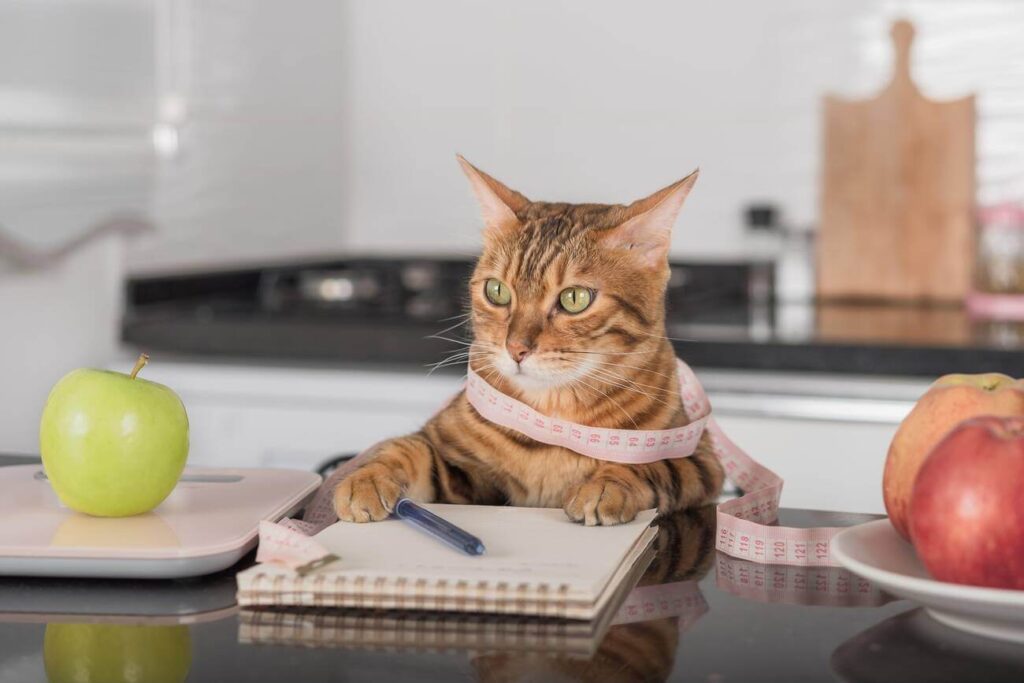If you want to make your own homemade vegan cat food recipes, I’ve got the perfect recipe for you.
You can feed your furry friend with this healthy and nutritious meal without worrying about any allergic reactions.
This is a great way to save money on pet care costs because these ingredients are affordable and easy to find in your local grocery store. All it takes is a little time and patience from you!
Why Go Vegan for Your Cat?
You might be wondering, why on earth would I want to feed my cat vegan food? Aren’t cats obligate carnivores? Well, here’s the scoop. While it’s true that cats need certain nutrients typically found in meat, you can absolutely meet those needs with a well-planned vegan diet.
Benefits of Vegan Cat Food
Healthier Ingredients: Homemade vegan cat food contains no animal byproducts, artificial colors, or preservatives. It’s all natural goodness!
Allergy Prevention: Many cats suffer from allergies caused by commercial cat food. Vegan recipes can help reduce these reactions.
Ethical Choice: If you’re vegan, it makes sense to extend those ethical choices to your pet’s diet too.
Getting Started with Homemade Vegan Cat Food

Before you jump into the kitchen, there are a few things to keep in mind. Making your own cat food isn’t just about tossing some veggies in a bowl. Cats have specific dietary requirements that must be met to keep them healthy.
Essential Nutrients
Your feline friend needs:
- Taurine: Critical for heart and eye health.
- Vitamin A: Important for vision and immune function.
- Protein: High-quality plant-based proteins are a must.
- Arachidonic Acid: An essential fatty acid for cats.
- Vitamin B12: Supports nerve function and red blood cell production.
Supplements
Don’t forget to add:
- Taurine supplements
- B12 supplements
- Arachidonic acid supplements
Basic Homemade Vegan Cat Food Recipes
Alright, let’s get cooking! Here’s a simple and nutritious recipe to get you started.
Ingredients
- 2 tablespoons of cooked chickpeas
- 1 cup of tofu, cubed or mashed
- One eggplant, roasted and sliced
- One cucumber, thinly sliced
- One sweet potato, thinly sliced
- 2 cups of white beans, rinsed and drained
- 1/3 cup of bok choy or kale, shredded
- 4 celery stalks, chopped
- 4 carrots, chopped
- 4 green onions, chopped
- One tablespoon of soy sauce
- 3 teaspoons of apple cider vinegar (optional)
Directions
- Cook and mash the chickpeas, then steam the tofu.
- Combine tofu and chickpeas in a bowl, mashing until they form a paste.
- Preheat your oven to 350°F (170°C). Roast the eggplant for about 20 minutes and slice it thinly.
- Peel and slice the sweet potato thinly.
- Mix eggplant, sweet potato, and cucumber in another bowl.
- Add the tofu-chickpea mixture and blend well.
- For each cup of tofu mixture, add ½ teaspoon of apple cider vinegar and mix thoroughly.
- Add the chopped vegetables, along with some cooked oatmeal or rice, until it has a dough-like texture.
- Mix in the soy sauce, and remaining ingredients, blending everything well.
- Scoop portions onto a baking sheet and bake for 40-50 minutes at 350°F (170°C).
- Let cool before serving. Store in an airtight container in the fridge for up to a week, or freeze for longer storage.
Evolution Diet Vegan Ultra Life Dry Cat Food
How to Feed Homemade Vegan Cat Food
Serving up your homemade vegan cat food is easy. Just make sure you follow these tips to keep your kitty happy and healthy.
Feeding Schedule
Feed your cat fresh food in the morning. Ensure they have access to fresh water all day long. You can split the recipe into two portions if you have a larger cat.
Storage
Store the food in an airtight container in the refrigerator. It’ll stay fresh for about three days. For longer storage, freeze in small portions. Frozen food will last for 3 to 6 months.
Transitioning to Vegan
If your cat is used to a meat-based diet, transition slowly. Mix small amounts of the vegan food with their usual food and gradually increase the vegan portion. This helps avoid digestive upset.
More Ideas for Homemade Vegan Cat Food
Once you get the hang of it, you can get creative with your recipes. Here are some additional ideas to keep your feline friend’s diet exciting.
Lentil and Veggie Delight
- Ingredients: Cooked lentils, carrots, peas, sweet potato, spinach, and quinoa.
- Directions: Cook all ingredients until tender. Blend or mash together and serve.
Bean and Grain Medley
- Ingredients: Black beans, brown rice, pumpkin, zucchini, and parsley.
- Directions: Cook beans and rice. Blend with chopped, cooked veggies.
Chickpea and Sweet Potato Mash
- Ingredients: Chickpeas, sweet potato, kale, and oats.
- Directions: Cook and mash chickpeas and sweet potato. Mix with finely chopped kale and cooked oats.
Wysong Vegan Feline/Canine Formula Dry Cat Food
Homemade cat food is usually healthier, but you should make sure that the ingredients are safe for your pet’s consumption when it comes to vegan recipes.
How To Store Your Homemade Vegan Cat Food After It’s Cooked?
Proper storage is key to keeping your homemade vegan cat food fresh and safe to eat.
Refrigeration
You can refrigerate or freeze the cooked vegan recipes so that your cat would eat them at a later date.
If you decide to refrigerate them, be aware that they will only stay fresh for 3 days, so you might want to cook in big batches and freeze in small portions.
Freezing
For longer storage, freeze portions in airtight containers or zip-lock bags. Defrost as needed. Frozen food can last up to 6 months.
What Quantities Should You Make Your Vegan Cat Food Recipes In?
It is important to know how many of these recipes you need to make at a time. You can cook a large batch and freeze it in batches to feed your cat in the future. It is optimal to use 1 cup of dry ingredients per 3 cups water.
Supplements in Homemade Vegan Cat Food
Supplements are not optional in a vegan cat diet. They are essential to ensure your cat gets all the nutrients they need.
Key Supplements
- Taurine: Essential for heart and eye health.
- B12: Supports nerve function.
- Arachidonic Acid: An essential fatty acid.
How to Add Supplements
Mix supplements into the food after cooking. Follow the recommended dosage on the supplement packaging.
3 Tips To Make Homemade Vegan Cat Food Recipes
To cook suitable food for your cats, you should keep in mind the following tips:
1. When it comes to vegan recipes, cats require a diet that’s rich in proteins. In this respect, plant-based protein sources can be extremely helpful.
Some include lentils and chickpeas; they may be used as the main ingredient in vegan cat food recipes. Because these products are rather inexpensive, you can afford to use them more often.
2. If your pet is used to consuming meat, you should know that it may find it difficult to adjust to a plant-based diet. That’s why you need some time before switching over to vegan recipes.
However, it would be best not to abruptly introduce your cats to such a diet as this may cause some digestive issues that would be difficult to address.
3. Vegan recipes usually require additional supplements such as taurine and arachidonic acid. These components are usually included in commercial pet foods; however, they’re not present in vegan recipes because they can be found in animal byproducts.
You’ll need to include these components if you don’t want your cats to suffer from serious health issues.
How Often Should You Feed Vegan Cat Food?
Homemade vegan cat food can be used as a supplement to commercial pet food; however, you should not exceed the daily dose recommended by your veterinarian. This is especially important if your feline pet is not accustomed to such a diet, so you should gradually introduce it.
Making homemade vegan food for cats may take considerable time and effort; however, it will be rewarding – your beloved pets will feel much better after switching to healthier diets only.
Also Read: Best 5 Homemade Cat Food Recipes for Senior Cats
What Are The Benefits Of Homemade Vegan Cat Food Recipes?
Homemade vegan cat food has numerous benefits.
Vegan recipes for cats are exceptionally healthy as they do not include animal byproducts, which can make your feline feel sick and tired.
Homemade vegan cat food may be more nutritious than commercial pet foods, but since you’re the person who prepares it, you’ll have complete control over the ingredients that go into it.
In order to make a suitable vegan food for your cat, you can use any component that’s healthy and pet-friendly. There are many recipes available on the Internet; however, you’ll need to make some changes to accommodate your feline’s preferences.
Feeding your pet with vegan food is especially helpful if it has certain health problems, as this diet may improve the symptoms.
To adjust your pet to vegan recipes, you should gradually introduce them to such foods by mixing them with commercial meals until they get used to the new cuisine. If you follow this approach, you can rest assured that your cat will get all of its nutritional needs met while enjoying an exceptional diet only.
What Are The Vegan Recipes That Can Be Used As Cat Food?
There are plenty of vegan recipes that can double as cat food. Here are a few examples.
Lentil-Based Recipes
Lentils are rich in protein and fiber, making them great for cat food.
Bean-Based Recipes
Black beans, pinto beans, and chickpeas are excellent sources of protein and minerals.
Grain-Based Recipes
Quinoa, brown rice, and oats can provide necessary carbohydrates and fibers.
Conclusion
So there you have it, a comprehensive guide to Homemade Vegan Cat Food Recipes. Making your own cat food at home can be rewarding and beneficial for your furry friend’s health. Remember to keep it balanced with essential nutrients and supplements. Your cat will not only enjoy the tasty meals but also thrive on a well-planned vegan diet. Happy cooking!



